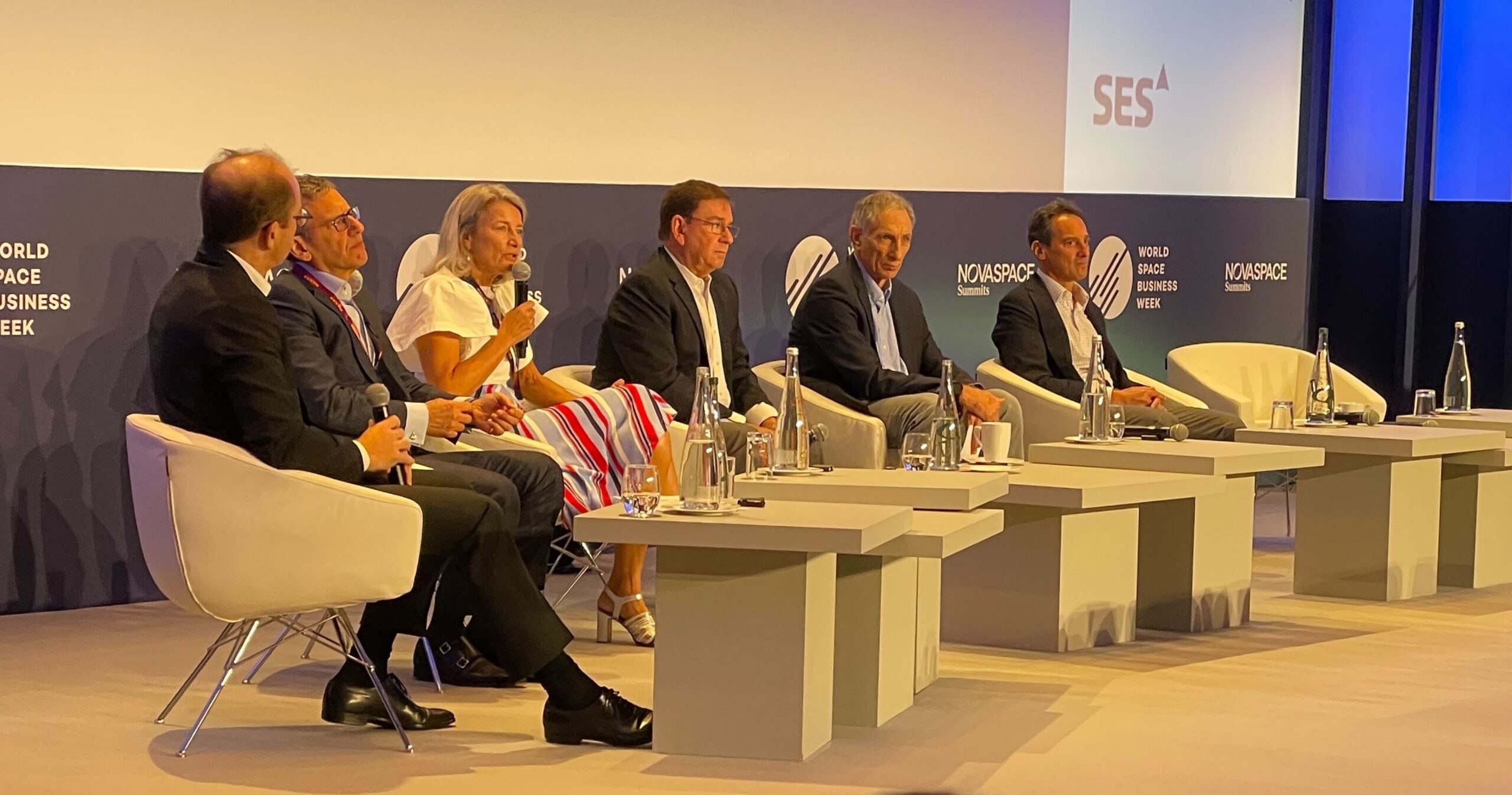Latest News

From left: Novaspace CEO Pacome Revillon; Echostar CEO Hamid Akhavan; Eutelsat CEO Eva Berneke; Intelsat CEO David Wajsgras; Viasat CEO Mark Dankberg; and Telesat CEO Dan Goldberg at World Space Business Week in Paris. Photo: Via Satellite
PARIS — The satellite industry is undergoing massive change as many of the largest satellite operators consolidate to deal with competition from SpaceX’s Starlink constellation.
During the operator panel in Paris at World Space Business Week on Sept. 16, Viasat CEO Mark Dankberg described the current environment as a “quantum period of change” unlike anything he has seen in the industry in 40 years. Viasat is one of the leaders of the industry consolidation after acquiring Inmarsat last year.
Dankberg said there has been “good progress” integrating the two companies. He highlighted the importance of access to L-band spectrum and the benefits that could be derived from that. “We see this as a powerful tool for the D2D market,” he said.
Dankberg reported that demand on the commercial side remains strong, citing 20 to 30 percent user demand growth every year. “Some of the traditional supply chain players are having a difficult time keeping up with that pace,” he said. “There is definitely a need for multi-orbit, multi-band. There is a lot to keep up with.
Addressing defense concerns, Dankberg said that nation-states are taking greater note of the importance of space, Dankberg said, especially in terms of how space impacts border control and other internal issues.
“Space is a shared domain, but a fairly fragile domain,” Dankberg said. “Nations are seeing the need for space and want to participate in it and control it.”
Intelsat CEO David Wajsgras acknowledged that while it is an “increasingly competitive” environment for operators, it’s an opportunity for the industry to focus on what its customers and end users want. Wajsgras said Intelsat is seeing increased demand for bandwidth across all of its verticals.
“The demand equation is getting more and more compelling,” Wajsgras said. “We see land mobility as an untapped opportunity. We are continuing to see increased demand from the government space, the defense and security space, with the U.S. and our key allies. We want to offer a multi-orbit solution to customers around the world. Scale is important. I am very optimistic about the industry.”
Wajsgras also previewed an upcoming multi-year Intelsat deal with a telco that comes with the opportunity to work across different verticals. Intelsat is currently going through a deal to be acquired by fellow operator SES, a company that was not on the panel.
Telesat is making progress on its Lightspeed Low-Earth Orbit (LEO) constellation and just finalized its financing agreements with the government of Canada and the government of Quebec.
Goldberg told the audience that Telesat is making “good progress” in executing the next stage and that manufacturer MDA Space is “ratcheting up their supply chain.” He said more Telesat announcements are coming in the near term.
Like others, Goldberg spoke of the dramatic change taking place in the industry, and how this led to Telesat placing a greater emphasis on LEO going forward. Goldberg said that while Telesat is focused on building Lightspeed, it’s also focused on how the company will serve customers on the network.
“One thing to build a great network, you need the right channels to get it to users out there. We are focused on the enterprise market – telcos, MNOs, ISPs, maritime, government, aero, etc. Our ecosystem is evolving very quickly. Some verticals evolve differently. We work with service providers and integrators,” he said. “By the time Lightspeed is available, what will that ecosystem look like? All the customers want the same thing – high throughput links, resiliency, security, ubiquity and at a lower cost. However, not all solution providers are the same.”
Goldberg believes customers don’t want one player to dominate the market. He added, “No user wants to put their eggs in one basket. Our customers want to have multiple operators.”
Eutelsat CEO Eva Berneke highlighted the need for sovereign capacity as one of the biggest trends right now in the market. She also spoke about the importance of the IRIS² program in Europe and the importance of having an alternative to a fully verticalized ecosystem.
“It is an alternative to building silo technology stacks,” Berneke said. “How do we put the right set of suppliers behind IRIS²? It is opening up a rethinking. It is a great opportunity for the ecosystem. We really want to see a very strong ecosystem. Having that in Europe is what IRIS² is about.”
Berneke also talked about the potential in the telco market, reporting that admitting advancements in satellite have made the discussions with telcos “more vibrant.
EchoStar CEO and President Hamid Akhavan, pointed to the large opportunity for greater satellite penetration. “There is a lot of potential,” Akhavan said. “The roadmap reminds me of the mobile business. 5G has been an amazing standard. All of these open systems are able to connect together.”
Get the latest Via Satellite news!
Subscribe Now